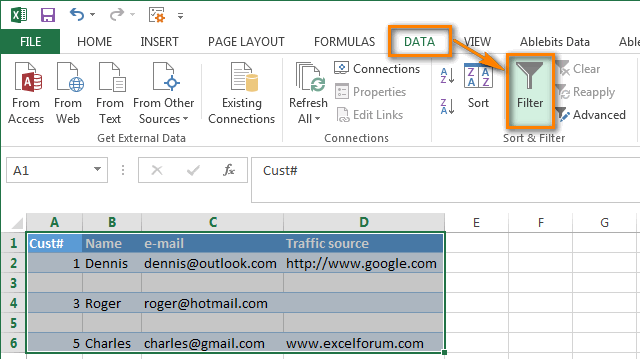

#Removing rows that have an empty cell in excel for mac mac#
The method applies to both Mac and Windows, but as I don't work on a Windows regularly I'm not entirely sure the Windows version does require some additional steps. So, today I will show you a very simple trick to delete blank rows from excel spreadsheets. click ok, now all blank cells in the selection have been selected. in the go to special dialog, check blanks option. select the range you want to remove blank rows, click home tab, then in editing group, click find & select > go to special. Well, you are probably not adding a blank row if you know this causes problem, but it is likely that before working on the spreadsheet you have used the import tool to get raw data from somewhere else (like a text file or a CSV file). Now please do as below steps to remove empty rows with go to special rows: 1. For what sake should I add an empty row if this creates me trouble? And blank rows or cells are a common problem, especially if we are going to use the filter to order the items in your list, which definitely don't love empty cell/rows (well the Windows version of Excel 2010 seems to manage pretty well them, but this is not happening with Excel 2011 for Mac). You can always ask an expert in the Excel Tech Community or get support in the Answers community.Working with spreadsheets mean inevitably to face with importing data sooner or later. To display zeros, clear the Empty cells as check box. To display blank cells, leave the box empty. Select the Empty cells as check box, and then in the box, type the value that you want to display in empty cells.

To display errors as blank cells, leave the box empty.ĭisplay a certain value in place of an empty cell On the Display tab, do one or more of the following:ĭisplay a certain value in place of an error codeĬheck the Error values as box, and then in the field, type the value that you want to display instead of an error code. On the PivotTable tab, under Data, click Options. The formula in cell A3 returns a zero (0) value, and Excel displays the value located between the quotation marks in the then argument (also called the value_if_true argument). Under Arguments, click the box next to then and do one of the following:Ĭlick the box next to else and type A3, then press the Enter key. Under Arguments, click the box next to value2 and type 0. Under Arguments, click the word True next to is, and then on the pop-up menu, click = (Equal To). Under Arguments, click the box next to value1 and type A3. In the Formula Builder list, double-click IF. On the Formulas tab, in Function, click Formula Builder. In cell A3, type =A1-A2, and then press RETURN. On a blank sheet, in cell A1 and cell A2, type 10. To learn more, see the IF function article. Select the radio button next to Blanks: When you hit OK, you’ll see that only blank cells are now selected: In the Cells section of the Home tab, click Delete. Next, in the Home tab, click on Find & Select, and click Go To Special. You can use the IF function to specify a condition that displays a zero (0) value as a blank cell or as a dash (-) in a cell. First, select the entire area you’d like to delete blank rows from.


 0 kommentar(er)
0 kommentar(er)
